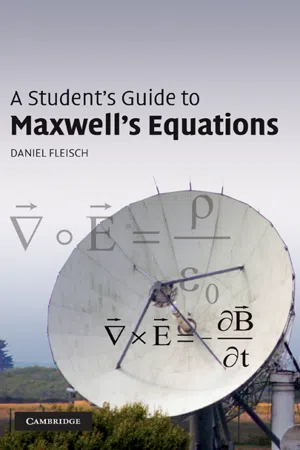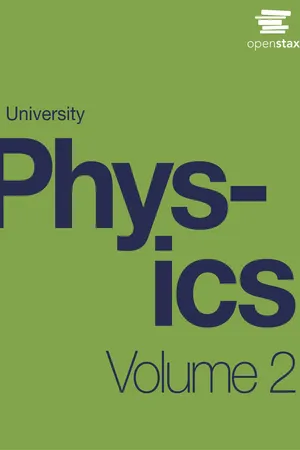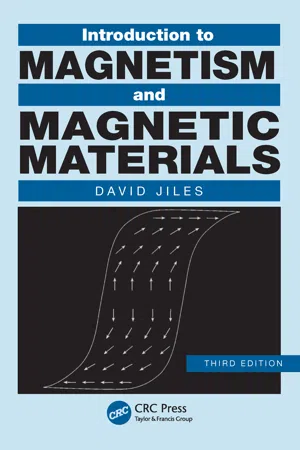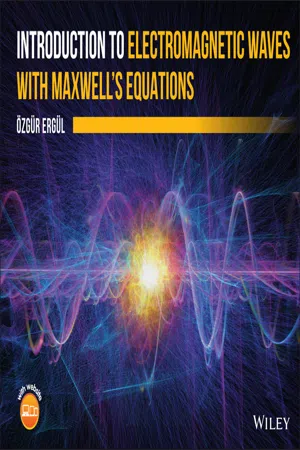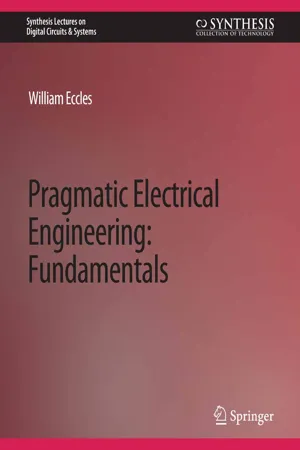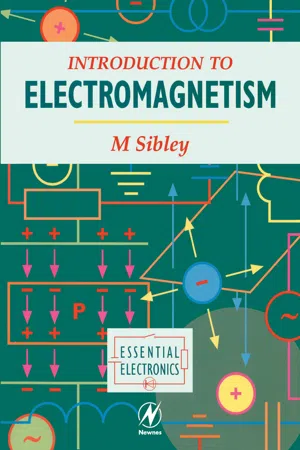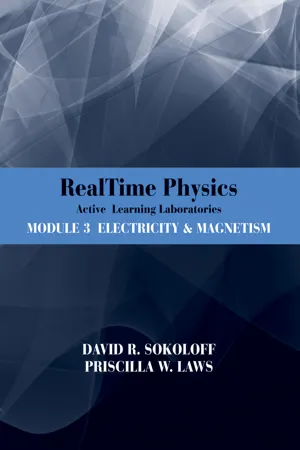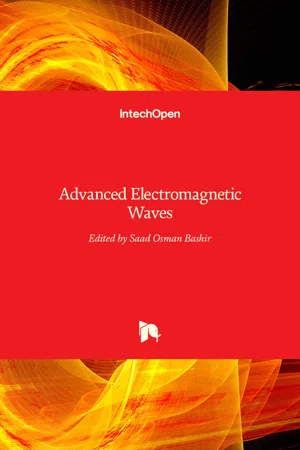Physics
Ampere's Law Magnetic Field
Ampere's Law describes the relationship between the magnetic field around a closed loop and the current passing through the loop. It states that the magnetic field is proportional to the current enclosed by the loop. This law is a fundamental principle in electromagnetism and is used to calculate the magnetic field produced by current-carrying conductors.
Written by Perlego with AI-assistance
Related key terms
1 of 5
10 Key excerpts on "Ampere's Law Magnetic Field"
- eBook - PDF
- Daniel Fleisch(Author)
- 2008(Publication Date)
- Cambridge University Press(Publisher)
4 The Ampere–Maxwell law For thousands of years, the only known sources of magnetic fields were certain iron ores and other materials that had been accidentally or deliberately magnetized. Then in 1820, French physicist Andre-Marie Ampere heard that in Denmark Hans Christian Oersted had deflected a compass needle by passing an electric current nearby, and within one week Ampere had begun quantifying the relationship between electric currents and magnetic fields. ‘‘Ampere’s law’’ relating a steady electric current to a circulating magnetic field was well known by the time James Clerk Maxwell began his work in the field in the 1850s. However, Ampere’s law was known to apply only to static situations involving steady currents. It was Maxwell’s addition of another source term – a changing electric flux – that extended the applicability of Ampere’s law to time-dependent conditions. More importantly, it was the presence of this term in the equation now called the Ampere–Maxwell law that allowed Maxwell to discern the electro-magnetic nature of light and to develop a comprehensive theory of electromagnetism. 4.1 The integral form of the Ampere–Maxwell law The integral form of the Ampere–Maxwell law is generally written as I C ~ B d ~ l ¼ l 0 I enc þ e 0 d dt Z S ~ E ^ n da The Ampere – Maxwell law : The left side of this equation is a mathematical description of the circulation of the magnetic field around a closed path C . The right side 83 includes two sources for the magnetic field; a steady conduction current and a changing electric flux through any surface S bounded by path C . In this chapter, you’ll find a discussion of the circulation of the mag-netic field, a description of how to determine which current to include in calculating ~ B , and an explanation of why the changing electric flux is called the ‘‘displacement current.’’ There are also examples of how to use the Ampere–Maxwell law to solve problems involving currents and magnetic fields. - eBook - PDF
- William Moebs, Samuel J. Ling, Jeff Sanny(Authors)
- 2016(Publication Date)
- Openstax(Publisher)
We then generalize these results to an important law of electromagnetism, called Ampère’s law. We examine some devices that produce magnetic fields from currents in geometries based on loops, known as solenoids and toroids. Finally, we look at how materials behave in magnetic fields and categorize materials based on their responses to magnetic fields. Chapter 12 | Sources of Magnetic Fields 535 12.1 | The Biot-Savart Law Learning Objectives By the end of this section, you will be able to: • Explain how to derive a magnetic field from an arbitrary current in a line segment • Calculate magnetic field from the Biot-Savart law in specific geometries, such as a current in a line and a current in a circular arc We have seen that mass produces a gravitational field and also interacts with that field. Charge produces an electric field and also interacts with that field. Since moving charge (that is, current) interacts with a magnetic field, we might expect that it also creates that field—and it does. The equation used to calculate the magnetic field produced by a current is known as the Biot-Savart law. It is an empirical law named in honor of two scientists who investigated the interaction between a straight, current-carrying wire and a permanent magnet. This law enables us to calculate the magnitude and direction of the magnetic field produced by a current in a wire. The Biot-Savart law states that at any point P (Figure 12.2), the magnetic field d B → due to an element d l → of a current-carrying wire is given by (12.1) d B → = µ 0 4π Id l → × r ^ r 2 . Figure 12.2 A current element Id l → produces a magnetic field at point P given by the Biot-Savart law. The constant µ 0 is known as the permeability of free space and is exactly (12.2) µ 0 = 4π × 10 −7 T ⋅ m/A in the SI system. - David Jiles(Author)
- 2015(Publication Date)
- CRC Press(Publisher)
459 Solutions to Exercises CHAPTER 1 E XERCISE 1.1: D EFINITION OF A MPERE The ampere is defined as the current that, when passed along two infinite conduc-tors lying parallel to each other 1 m apart, gives rise to a force per unit length of 2 × 10 − 7 N m − 1 . From Ampère’s circuital law, the magnetic field H at a radial distance a from a long conductor carrying current i is H = i a 2 1 π A m -Therefore, the field at a distance of 1 m from a long linear conductor carrying a current of 1 A is H = -1 2 1 π A m The force per unit length, F / l , on a current-carrying conductor with current i caused by a perpendicular magnetic induction B is F l i = B and in this case F / l = 2 × 10 − 7 N m − 1 , and i = 1 A. Therefore, B = × 2 10 7 -T Now since by definition B = μ 0 H , then the magnetic induction of 2 × 10 − 7 T corre-sponds to a magnetic field in free space of 1/2 π A m − 1 , and so μ π 0 7 1 4 10 = = × B H --H m E XERCISE 1.2: D IFFERENCE BETWEEN H AND B An essay on the difference between B and H should concentrate on the two Maxwell equations, which relate to these quantities: 460 Solutions to Exercises ∇× = + ∂ ∂ ∇× = -∂ ∂ H t t J D E B or equivalently the Ampère circuital law for H , H ⋅ = ∫ dl Ni or its Biot-Savart law form dH i d l r = × 1 4 2 π ˆ r and the Faraday-Lenz law of induction for B , V NA d dt = -B and the Ampère force law (Ampère’s other law) in its various forms F B m B B = × = × = × i dl qv the last of these also being known as the Lorentz force law , although it is essentially just the Ampère force law in a slightly different form. A field strength of 1 A m − 1 is generated at the center of a circular coil of conductor of diameter 1 m when it carries a current of 1 A. A magnetic induction of 1 T generates a force of 1 N m − 1 on a conductor carrying a current of 1 A perpendicular to the direction of the induction. The main difference between these quantities is then clear.- eBook - PDF
- David Halliday, Robert Resnick, Jearl Walker(Authors)
- 2021(Publication Date)
- Wiley(Publisher)
Ampere’s Law We can find the net electric field due to any distribution of charges by first writing the differential electric field dE → due to a charge element and then summing the contributions of dE → from all the elements. However, if the distribution is compli- cated, we may have to use a computer. Recall, however, that if the distribution has planar, cylindrical, or spherical symmetry, we can apply Gauss’ law to find the net electric field with considerably less effort. Similarly, we can find the net magnetic field due to any distribution of currents by first writing the differential magnetic field d B → (Eq. 29.1.3) due to a current- length element and then summing the contributions of d B → from all the elements. Again we may have to use a computer for a complicated distribution. However, if the distribution has some symmetry, we may be able to apply Ampere’s law to find the magnetic field with considerably less effort. This law, which can be derived from the Biot–Savart law, has traditionally been credited to André-Marie Ampère Checkpoint 29.2.1 The figure here shows three long, straight, parallel, equally spaced wires with identical currents either into or out of the page. Rank the wires according to the magnitude of the force on each due to the currents in the other two wires, greatest first. a b c 29.3 AMPERE’S LAW Learning Objectives After reading this module, you should be able to . . . 29.3.1 Apply Ampere’s law to a loop that encircles current. 29.3.2 With Ampere’s law, use a right-hand rule for determining the algebraic sign of an encircled current. 29.3.3 For more than one current within an Amperian loop, determine the net current to be used in Ampere’s law. 29.3.4 Apply Ampere’s law to a long straight wire with current, to find the magnetic field magnitude inside and outside the wire, identifying that only the current encircled by the Amperian loop matters. Key Idea ● Ampere’s law states that ∮ B → ⋅ d s → = μ 0 i enc (Ampere’s law). - Ozgur Ergul(Author)
- 2021(Publication Date)
- Wiley(Publisher)
(2.339) In other words, we are able to use Ampere’s law for the magnetic flux density, while we cannot place the permeability outside the derivative (curl operation). In such a case, the derivative of the permeability (its gradient) may be used to write the complete and correct equation for ¯ ∇ × ¯ B m (¯ r, t ). We may now construct the mathematical basis for the interaction of magnetic fields with magnetic materials, particularly in the context of Ampere’s law. As usual, we list the tools and concepts for this purpose: • Magnetic dipole • Magnetization • Equivalent magnetization currents These are in addition to previous tools: differential length with direction (Section 2.1.1 ), cross product (Section 2.3.2 ), circulation of vector fields (Section 2.1.2 ), electric current den-sity (Section 2.3.1 ), curl of vector fields (Section 2.3.3 ), and Stokes’ theorem (Section 2.3.4 ). Also, we need to know differential surface with direction (Section 1.1.1 ), dot prod-uct (Section 1.1.2 ), and flux of vector fields (Section 1.1.3 ). 2.8.1 Magnetic Dipole As opposed to the existence of electric charges, there is no magnetic charge in nature (Figure 2.80 ). On the other hand, a magnetic dipole, which creates a magnetic field that is similar 82 to the electric field created by an electric dipole, can be defined as a 82 This similarity is particularly for the far zone: i.e. away from the dipole. circular loop carrying a constant electric current (Figure 2.81 ). Consider a steady I 0 flowing Ampere’s law 133 along a loop of radius a located at the origin in a vacuum. The magnetic field intensity at an arbitrary location ¯ r can be found as B -Figure 2.82 Magnetic field lines for a magnetic dipole. Magnetic dipoles are very useful to describe various phenomena, such as magnetization.- eBook - PDF
Pragmatic Electrical Engineering
Fundamentals
- William Eccles(Author)
- 2022(Publication Date)
- Springer(Publisher)
One is the force created between current-carrying conductors. Ampere’s Law tells us what the force is, which we use to consider the mechanical stresses on conductors and their supports and enclosures. The other side is the field relationships. These we’ll use to see how force is created in an air gap in a magnetic structure and while we are at it, how inductance comes about. Work backward through this section: • A current flowing through the wires of a coil creates a magnetomotive force, mmf, F, that provides the magnetic field. • From the mmf, F, and the length of the magnetic path, we can get the magnetic field intensity H = Ni/ , where is the length of the path. • The magnetic flux density B = μH, where μ is either μ = 4π x10 −7 for air or a much larger number for magnetic materials. • Finally, the total flux = BA, where A is the cross sectional area of the magnetic path. We will use some of this in the next section to develop the magnetic concept of reluctance and from there, inductance. Our goal with these is to be able to find the force in an air gap in a magnetic structure, which will be useful for converting electrical energy into mechanical energy. 168 6. ELECTROMAGNETICS 6.3 RELUCTANCE AND INDUCTANCE Reluctance is a strange-sounding term that sort of conveys the same idea as resistance. Grammatically, they aren’t all that far apart. “I resist going to the pub tonight because I have to study.” “I am reluctant to go to the pub….” 6.3.1 RELUCTANCE Let’s play with the equations we already have to get to the concept of reluctance. First, we relate magnetomotive force to magnetic field intensity and then to magnetic flux density, all of this in some magnetic structure that has a magnetic path length (a closed path) of : = = H B C C + F Now move from flux density to flux by giving the magnetic path a cross-sectional area A: B A = Φ Gather terms and rearrange things a bit: = = £ ¤ ² ¥ ¦ ´ \ \ A A + + C C F Interesting result? I think so! Look at what it says. - eBook - PDF
- M. Sibley(Author)
- 1995(Publication Date)
- Butterworth-Heinemann(Publisher)
We begin by studying the field produced by a long, current-carrying conductor . This will introduce us to Ampere' s circuital law« (Although Ampere's circuital law came before the Biot-Savart law, the way our electromagneti c mode l has de¥eloped dictates this approach» ) 3.6 MAGNETIC FIELD STRENGTH AND AMPERE'S CIRCUITAL LAW Let us conside r the current-carrying wire shown in Fig. 3.6. We want to find the magneti c ield strengt h at a point P, distance R from the wire. To ind H at this point, we will determine the field strengt h due to a smal curren t element , and then integrat e the resul t over the length of the wire. By applying the Biot-Savar t law, we get ., Idz ' (319) ÛH--4nr 2 sin 6 A m * acting into the page» Now, to find the total field strength , we need to integrat e Equation (3.19) with respec t to length, Unfortunately, as we move along the wire, the distance r and the angle 8 will vary. So 9 we need to do some substitution and manipulation before we can do any integration» Magnetic field acting into lie page Fig. 3.6 The magnetic field of an infinitely long current-carrfing wire (3.20) 3.6 Magnetic field strength and Ampere's circuital law 75 Insteadof working with the angle e, we can simplifytheintegrationif we use the angle «instead.So, withreferenceto Fig. 3.6, we can see thatz = R tan a, and so dz = R de/cos' o, As sin e = Rlr = cos rx, we get r = Rlcos o. Thus Equation (3.19) becomes I R do cos 2« dH = ----2---2-cos « 4'1T cos« R Now, as we move from -oc to +00 the angle o varies from -'1T/2 to +'1T/2. So, I +,,12 H = ._-f cos o do 4'1TR -,,12 = --l--Isin « +,/2 4'1TR -,,/2 I =-(1+1) 4'1TR and so, I H = --into thepage. 2'1TR Let ustakeamomentto examinethis equation in some detail. It showsthatthe magneticfield strengthis proportionalto the currentin the wire. We should expectthis becausecommonsense tells us thata largemagneticfield implies a largecurrent.However, H is also inverselydependent on theterm 2'1TR. - eBook - PDF
RealTime Physics: Active Learning Laboratories, Module 3
Electricity and Magnetism
- David R. Sokoloff, Priscilla W. Laws(Authors)
- 2012(Publication Date)
- Wiley(Publisher)
LAB 10: ELECTROMAGNETISM 193 LAB 10: ELECTROMAGNETISM Name Date Partners S Motion Conductor Voltmeter 0.010 volts N When the magnet is introduced, the needle at the galvanometer is deflected in a certain direction; but being in, whether it be pushed quite through or withdrawn, the needle is deflected in a direction the reverse of that previously produced. When the magnet is passed in and through at one continuous motion, the needle moves one way, is then suddenly stopped, and finally moves the other way. Michael Faraday (1791–1867) OBJECTIVES • To observe the magnetic field produced by electric current flowing in a straight wire and invent a right hand rule to determine the direction of the associated field lines. • To discover under what circumstances a magnetic field can induce a voltage in a coil of wire. • To relate the voltage and current induced in a coil of wire to the rate of change of magnetic flux passing though it. • To verify Faraday’s law of electromagnetic induction. • To verify Lenz’s law of electromagnetic induction. OVERVIEW In the last lab you observed that permanent magnets can exert forces both on freely moving charges and on electric currents in conductors. We have postulated the existence of a mathematical entity called the magnetic field in order to intro- duce the Lorentz force law as a way of describing mathematically the nature of the force that a magnet can exert on moving electrical charges. Newton’s Third law states that whenever one object exerts a force on another object, the second object exerts an equal and opposite force back on the first object. Thus, if a 194 REALTIME PHYSICS: ELECTRICITY AND MAGNETISM magnet exerts a force on a current-carrying wire, shouldn’t the wire exert an equal and opposite force back on the magnet? It is not unreasonable to speculate that currents and moving charges exert these forces by producing magnetic fields them- selves. - No longer available |Learn more
Physics for Scientists and Engineers
Foundations and Connections, Extended Version with Modern Physics
- Debora Katz(Author)
- 2016(Publication Date)
- Cengage Learning EMEA(Publisher)
Faraday’s law, one of Maxwell’s equations 2. Lenz’s law Copyright 2017 Cengage Learning. All Rights Reserved. May not be copied, scanned, or duplicated, in whole or in part. WCN 02-300 32-1 Another Kind of Emf 1011 Unless otherwise noted, all content on this page is © Cengage Learning. 32-1 Another Kind of Emf There are two different kinds of electric field sources. We studied the first type, in- cluding sources with excess charge, such as the spheres and rods used by Ben Frank- lin and his contemporaries. We also studied the practical application of charged sources such as Leyden jars and batteries, which have excess positive charge on one terminal and excess negative charge on the other. It is convenient to characterize these sources in terms of the electric potential difference between their terminals, known as their emf (Section 29-1). As you know, a current results when the terminals of such an emf are connected by a conductor (Fig. 32.1). About four decades after Franklin died, the British physicist Michael Faraday (1791–1867) discovered another kind of electric field source. This source is a chang- ing magnetic flux F B . Like a battery, a changing magnetic flux creates current in a conductor. We usually use the phrases “the battery sets up a current” and “the chang- ing magnetic flux induces a current.” Because Faraday’s law is based on his laboratory observations, let’s begin by considering a few experiments. Figure 32.2 shows a wire connected to an ammeter, but—unlike the wire in Figure 32.1—there is no battery connected to the wire. A solenoid passes through the rectangular loop with its long axis perpendicular to the page. The solenoid is connected to an external circuit (not shown) so that it creates a uniform magnetic field B u pointing out of the page. Recall that outside an ideal solenoid, the magnetic field is zero. - eBook - PDF
- Saad Osman Bashir(Author)
- 2015(Publication Date)
- IntechOpen(Publisher)
Chapter 3 The Electromagnetic Force between Two Parallel Current Conductors Explained Using Coulomb’s Law Jan Olof Jonson Additional information is available at the end of the chapter http://dx.doi.org/10.5772/61221 Abstract In this book chapter the electromagnetic force between two parallel electric conduc‐ tors has been derived, applying thereby the effects of propagation delay and the Spe‐ cial Relativity theory, taking thereby also into count the thus far neglected effects introduced by the voltage sources of both circuits. This has been done for a specific case consisting of two rectangular circuits, aligned to each other along one of the long sides, at a distance that is short compared to the long sides. The intention in doing so is to make a meaningful application of the concept of “two parallel conductors of in‐ finite length”, so that it is possible to make a complete calculation of the force between the two circuits, avoiding thus making a vague claim as for example Maxwell, saying that the other parts of the conductors do not contribute to the force. What is radically new in this interpretation is that it is Coulomb’s law that is responsible for the force. Keywords: Ampère’s Bridge, Ampère’s Law, Coulomb’s Law, electromagnetic force, Lorentz force, Lorentz transformation, parallel conductors, propagation delay, retard‐ ed action, Special Relativity theory, Sagnac effect, time dilatation 1. Introduction In several papers evidence has been presented that is able to refute the widely recognized electromagnetic theory of today [1-5]. One such fundamental law is Lorentz’ force law. Already 1997 a paper presented mathematical proofs showing that this law is unable to explain the repulsive force between collinear currents, demonstrated in the case of Ampère’s bridge [1]. Even Graneau’s exploding wires and Hering’s pump cause difficulties, when trying to use Lorentz’ force law in order to explain the effects that have been registered [6-11].
Index pages curate the most relevant extracts from our library of academic textbooks. They’ve been created using an in-house natural language model (NLM), each adding context and meaning to key research topics.
